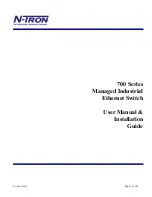
23
Login method
Default state
By default, you cannot log in to a device through a network management
system (NMS). To do so, log in to the device through the console port, and
complete the following configuration:
•
Configure the IP address of the VLAN interface, and make sure the device
and the NMS can reach each other (by default, your device does not have
an IP address.).
•
Configure SNMP basic parameters.
User interface overview
A user interface, also called line, enables you to manage and monitor sessions between the terminal and
the device when you log in to the device through the console port, Telnet or SSH.
A single user interface corresponds to a single user interface view where you can configure a set of
parameters, such as whether to authenticate users at login, and the user privilege level after login.
When the user logs in through a user interface, the connection follows these parameter settings,
implementing centralized management of various sessions.
At present, the system supports the following CLI configuration methods:
•
Local configuration via the console port
•
Local or remote configuration through Telnet or SSH
The CLI configuration methods correspond to the following types of user interfaces:
•
AUX user interface: Manages and monitors users that log in via the console port. The type of the
console port is EIA/TIA-232 DCE.
•
VTY (virtual type terminal) user interface: Used to manage and monitor users that log in via VTY. A
VTY port is a logical terminal line used for Telnet or SSH access.
Users and user interfaces
At a time, only one user can use a user interface. The configuration made in a user interface view applies
to any user logged in to that user interface. For example, if user A uses the console port to log in, the
configuration in the AUX port user interface view applies to user A. If user A logs in through VTY 1, the
configuration in the VTY 1 user interface view applies to user A.
A device can support one AUX user interface and 16 VTY user interfaces. These user interfaces are not
associated with specific users. When a user initiates a connection request, the system automatically
assigns the idle user interface with the smallest number to the user based on the login method. During
login, the configuration in the user interface view takes effect. The user interface varies depending on the
login method and login time.
Numbering user interfaces
User interfaces are numbered by using absolute numbering or relative numbering.
Absolute numbering
Absolute numbering identifies a user interface or a group of different types of user interfaces. The
specified user interfaces are numbered from number 0 with a step of 1 and in the sequence of AUX and
















































